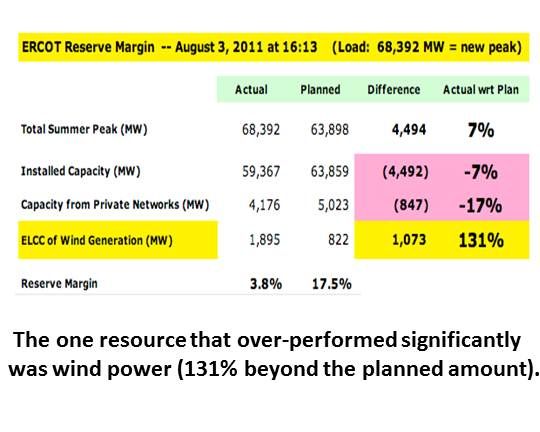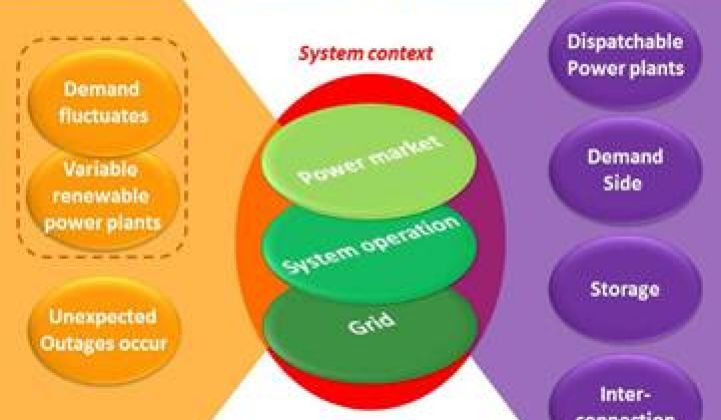The sun doesn’t always shine and the wind doesn’t always blow, but guess what? Coal plants don't work all the time, either.
Advanced grid management practices proved effective in easing power shortages twice this year in Texas with wind energy-generated electricity, according to Michael Goggin, the electric industry analyst for the American Wind Energy Association (AWEA).
In February, Goggin said, some 75 Texas coal and natural gas plants unexpectedly went partially or fully out of service due to unusually cold weather. There were rolling blackouts across much of the state. But the Electricity Reliability Council of Texas (ERCOT), the grid operator, still had the state’s U.S.-leading wind supply to help keep some of the lights on.
“All resources have reliability issues,” Goggin said. With up-to-date grid management capabilities, however, “a diverse portfolio of resources provides more tools to deal with unexpected losses and, therefore, more reliability.”
In early August, days of 105-degree-plus heat left ERCOT with a ten percent higher demand and a higher than average shortfall of conventional fossil fuel plant supply right when the use of power was peaking in the late afternoon. ERCOT had the capability, however, to integrate the rising supply of Texas coastal wind-generated electricity to help meet the crisis.
These Texas success stories demonstrate that research and modeling work done by Michael Milligan and other scientists at the National Renewable Energy Laboratory (NREL) accurately describes how U.S. grid operators must prepare for diversifying the nation’s power supply with variable renewable generation.

In a presentation sponsored by AWEA, Milligan discussed in detail the factors that affect the integration of large amounts of wind and solar. Following on landmark studies at NREL of the nation’s transmission systems, Milligan enumerated ten capabilities that will allow system operators to reliably and efficiently integrate, he said, “as much as 30 percent wind and 20 percent solar.”
The capabilities were: 1) a large balancing authority that provides a larger pool of resources; 2) geographically dispersed wind and solar; 3) forecasting of wind and solar effectively integrated into system operations; 4) rapid access for system operators to balancing sources in neighboring power markets; 5) non-spinning and 30-minute reserves for response to wind and solar variability events; 6) regional transmission planning that designs for economics and reliability; 7) a robust, smart, high-capacity electrical grid; 8) more flexible transmission service; 9) flexibility in generation from a full spectrum of resources; and 10) a responsive load facilitated by smart services.
There will be costs, Milligan said, but there is no agreement yet on how much they will be. On the other hand, he pointed out, there have always been costs for integrating the fluctuations and sudden outages associated with traditional generation. It is time, he suggested, to reach an equitable assessment of the costs for integrating the full portfolio of resources.
In the same AWEA session, Aidan Tuohy, Senior Project Engineer with the Electric Power Research Institute (EPRI), simplified Milligan’s detailed analysis. “Flexibility is the other half of variability,” he said, adding that “wind and solar variability and uncertainty increase the need for system flexibility.”
Demand fluctuates, renewable sources provide variable supply, and unexpected outages occur. For power markets and grid systems to accommodate all that, dispatchability, demand response capability, storage and an interconnected transmission system can all facilitate a flexible response.

Tuohy described a Flexibility Assessment (FAST) tool developed by the International Energy Agency (IEA) to quantitatively and qualitatively analyze a system’s readiness to accommodate larger amounts of wind energy and solar energy.
He offered a sort of five-step algorithm system operators can use to accommodate larger proportions of renewables. The operator 1) identifies -- over 15-minute, one-hour, six-hour and 36-hour timescales -- the spectrum of flexible resources; 2) checks to see which are available and 3) what the system’s needs are; and 4) compares resources and needs to 5) optimize resource deployment.
Tuohy emphasized the same spectrum of factors as Milligan did for maximizing flexibility. He drew on International Energy Agency (IEA) data to show how Denmark’s access to those factors will allow it to achieve a variable renewable energy penetration of 63% of its potential. The Nordic market can achieve 48% and the western U.S. can get to 45%. Japan, because of inherent limitations preventing access to some of the flexibility tools, may only achieve 19 percent of its variable renewable energy penetration potential.
The key messages, Tuohy reported, are: 1) variability is not an issue for grid operators at low penetrations and is manageable at high penetrations; 2) flexibility is the answer to variability; 3) many resources offer flexibility; 4) a strong intelligent grid is “critical”; 5) large, liquid markets incorporating forecasts work best; and 6) markets must be designed to prevent revenue losses from driving off flexible resources.
But they already know all that in Texas.



